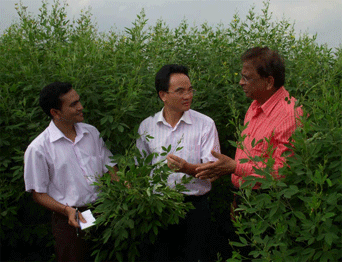|
April, 2009
Source:
CGIAR
newsletter, April 2009
The world’s first commercial hybrid of pigeonpea (called “red
gram” in India) is now taking root in China, after winning the
hearts of seed producers and farmers in India. The hybrid was
developed by the International
Crops Research Institute for the Semi-Arid Tropics (ICRISAT)
using cytoplasmic-nuclear male sterility (CMS) technology.
The first pilot program for hybrid seed production is being
undertaken by a farmers’ organization in Yuanmou County, in the
southwestern province of Yunnan.
China's first field training course on hybrid pigeonpea seed
production, held in Yunnan.
Pigeonpea is grown in southern China mainly to conserve soil on
150,000 hectares of sloping land. Hybrids perform better than
conventional cultivars by virtue of their fast canopy
development, greater biomass production and strong root system.
Pigeonpea hybrids are notable not only for their 30-40% yield
advantage over pure line cultivars, they also resist major
yield-reducing stresses such as drought, soil-borne diseases,
water-logging and soil salinity.
According to William Dar, director general of ICRISAT, China’s
interest in promoting ICRISAT’s hybrid pigeonpea is an
indication of the benefits that the new hybrid has over existing
pigeonpea varieties. “I am confident that the revolution we
started in India with hybrid pigeonpea will soon spread to
different parts of the world,” he said.
Store owned by a farmer association selling processed pigeonpea
products in Yunnan, China.
The Research Institute of Resource Insects (RIRI) in Kunming,
the capital of Yunnan Province, is spearheading the introduction
of CMS technology for hybrid pigeonpea development in China
jointly with the directorates of forestry and of science and
technology, as well as the Yuanmou Pigeonpea Farmers’
Association.
| |
 |
|
K.B.
Saxena (in pink shirt) with researchers in China |
| |
Under the supervision of Li
Zhenghong of RIRI, and with technical support from
Dr. K.B. Saxena,
ICRISAT’s principal pigeonpea breeder, Chinese farmers share
responsibility for producing seeds of the hybrids ICPH-2671 and
ICPH-3381 and their parents. Li is confident that the adoption
of hybrids and their mass seed production will help Chinese
farmers generate additional income.
Scientists from RIRI and the members of the Yuanmou Pigeonpea
Farmers’ Association are organizing a field-based training
program on mass hybrid seed production. The Chinese seed
producers are also exploring the possibility of exporting hybrid
seed to neighboring Myanmar.
The countries other than China where pigeonpea hybrid technology
will be introduced shortly are Brazil, Malawi, Myanmar and
Tanzania.
ICRISAT announced the launch of world’s first commercial
CMS-based pigeonpea hybrid in July 2008, in collaboration with a
private seed company partner, Pravardhan Seeds, which launched
ICRISAT’s hybrid ICPH-2671 under the name Pushkal.
Hybrid production requires a female plant in which no viable
pollen grains are borne. The expensive and labor-intensive
method of producing these male-sterile plants, which do not have
functional male sex organs, is to remove the male anthers from
the flowers. The simple, more productive way to establish a
female line for hybrid seed production is to identify or create
a line that is unable to produce viable pollen. This
male-sterile line is therefore unable to self-pollinate, and
seed formation depends upon pollen from another, male-fertile
line. This union produces progeny that perform better than
either parent because of heterosis, or hybrid vigor. Through CMS
technology, the genes for male sterility are transmitted through
the cytoplasm, or cell fluid, such that the entire progeny lacks
functional anthers.
In India, ICRISAT developed the CMS-based hybrid technology for
pigeonpea in collaboration with the Indian Council of
Agricultural Research (ICAR). It has worked over the past 2
years with private companies to develop seeds for the market. |
|